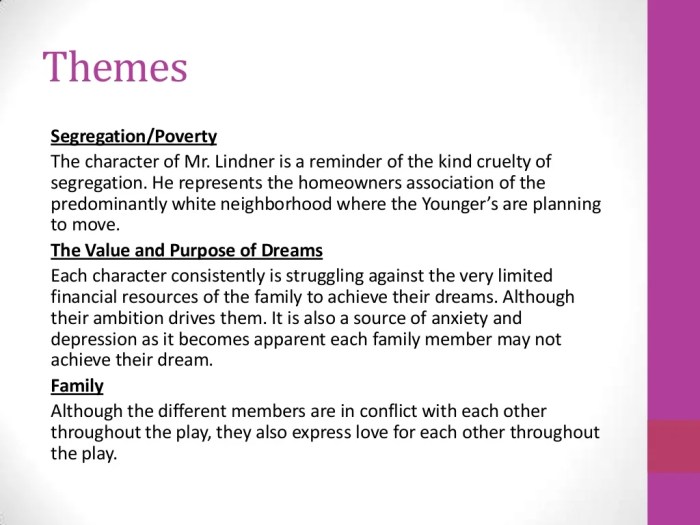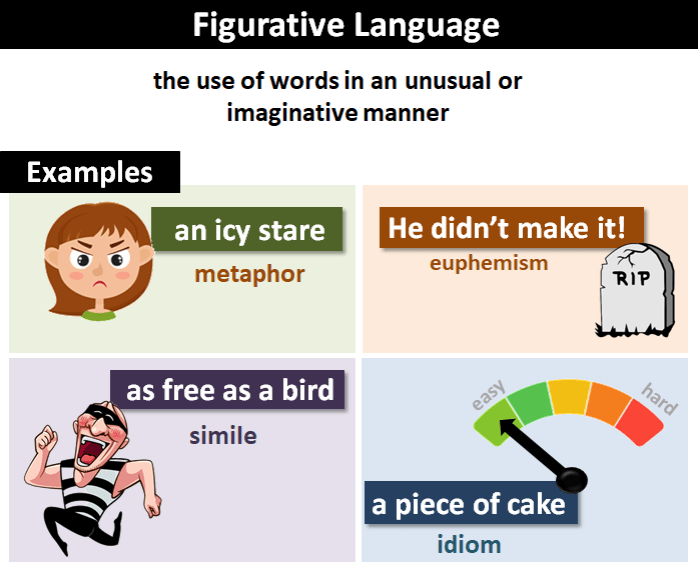Figurative language in a raisin in the sun – Figurative language in “A Raisin in the Sun” is a captivating exploration of literary devices that enhance the play’s themes, characters, and emotional depth. This profound work by Lorraine Hansberry employs similes, metaphors, and personification to create vivid imagery, express complex emotions, and illuminate social and cultural issues.
The playwright’s skillful use of figurative language not only enriches the play’s language but also provides deeper insights into the characters’ struggles, aspirations, and the broader human experience.
Introduction
Figurative language, an essential literary device, employs words and phrases beyond their literal meanings to create vivid imagery, express emotions, and convey deeper messages. In Lorraine Hansberry’s acclaimed play, “A Raisin in the Sun,” figurative language plays a pivotal role in shaping the narrative, characters, and themes.
Types of Figurative Language in “A Raisin in the Sun”

Similes
Similes compare two unlike things using “like” or “as.” For example, when Walter Younger says, “Life is like a piece of bread,” he equates the challenges of life to the difficulty of breaking through a hard crust.
Metaphors
Metaphors imply a direct comparison without using “like” or “as.” For example, Mama Younger’s description of Beneatha as “a volcano” suggests her passionate and explosive nature.
Personification
Personification attributes human qualities to non-human objects. For example, when Ruth refers to the house as “a dream,” it symbolizes the family’s longing for a better life.
Functions of Figurative Language in the Play

Create Vivid Imagery and Sensory Experiences
Figurative language evokes sensory experiences, making the play more immersive and engaging. For example, Walter’s description of the apartment as a “roach hotel” conjures up a vivid image of squalor and desperation.
Express Emotions and Psychological States
Figurative language allows characters to express their inner emotions and psychological states. For example, Beneatha’s comparison of herself to a “tree” conveys her feelings of being rooted and grounded.
Highlight Social and Cultural Issues
Figurative language can highlight social and cultural issues faced by the characters. For example, Mama Younger’s metaphor of the “fences” surrounding the family represents the racial barriers they encounter.
Examples and Analysis: Figurative Language In A Raisin In The Sun
Scene 1, Act 1
Walter Younger’s description of the apartment as a “roach hotel” uses personification to emphasize the deplorable living conditions. This metaphor reflects the family’s frustration and desperation.
Scene 2, Act 2, Figurative language in a raisin in the sun
Mama Younger’s comparison of Beneatha to a “tree” uses a metaphor to convey Beneatha’s strong and resilient character. This comparison highlights Beneatha’s ability to withstand adversity.
Impact on Characterization and Plot
Character Traits and Motivations
Figurative language reveals character traits and motivations. For example, Walter’s frequent use of similes and metaphors indicates his imaginative and ambitious nature.
Foreshadowing Events and Shaping the Plot
Figurative language can foreshadow events and shape the plot. For example, Mama Younger’s description of the house as a “dream” foreshadows the family’s eventual acquisition of a new home.
Symbolism and Archetypes
Symbolic Objects, Images, and Characters
Figurative language often employs symbolic objects, images, and characters. For example, the “raisin in the sun” symbolizes the family’s hope and dreams for a better future.
Representation of Deeper Meanings and Universal Experiences
Symbols represent deeper meanings and universal experiences. For example, the “fences” surrounding the family represent the racial barriers they face, while the “tree” represents Beneatha’s strength and resilience.
FAQ Summary
What is the significance of similes in “A Raisin in the Sun”?
Similes contribute to the play’s vivid imagery by comparing characters and situations to familiar objects or experiences, making them more relatable and impactful.
How does metaphor enhance the play’s emotional depth?
Metaphors create powerful connections between seemingly unrelated concepts, allowing the playwright to express complex emotions and psychological states in a concise and evocative manner.
What is the effect of personification in the play?
Personification breathes life into inanimate objects, giving them human qualities, which enhances the play’s emotional resonance and allows the audience to empathize more deeply with the characters.